Exploring the Potential of Recycled Polymers for 3D Printing Applications: A Review
Abstract
:1. Introduction
| Sector | Average Share of Total Polymer Demand (%) | Trends and Observations | Sources |
|---|---|---|---|
| Packaging | 40–45 | Dominant sector, increased use of biodegradable polymers. | PlasticsEurope, European Bioplastics, Statista. |
| Construction | 20–25 | Steady demand, focus on energy-efficient materials. | PlasticsEurope, European Commission Reports. |
| Automotive | 8–10 | Lightweighting, growth in engineering plastics. | PlasticsEurope, European Automobile Manufacturers Association. |
| Electric and electronics | 5–7 | Growth in consumer electronics, miniaturization. | PlasticsEurope, European Chemical Industry Council (CEFIC). |
| Agriculture | 3–5 | Biodegradable films, precision farming technologies. | PlasticsEurope, European Bioplastics. |
| Consumer goods | 10–12 | High-performance, aesthetically pleasing products. | PlasticsEurope, Statista, European Bioplastics. |
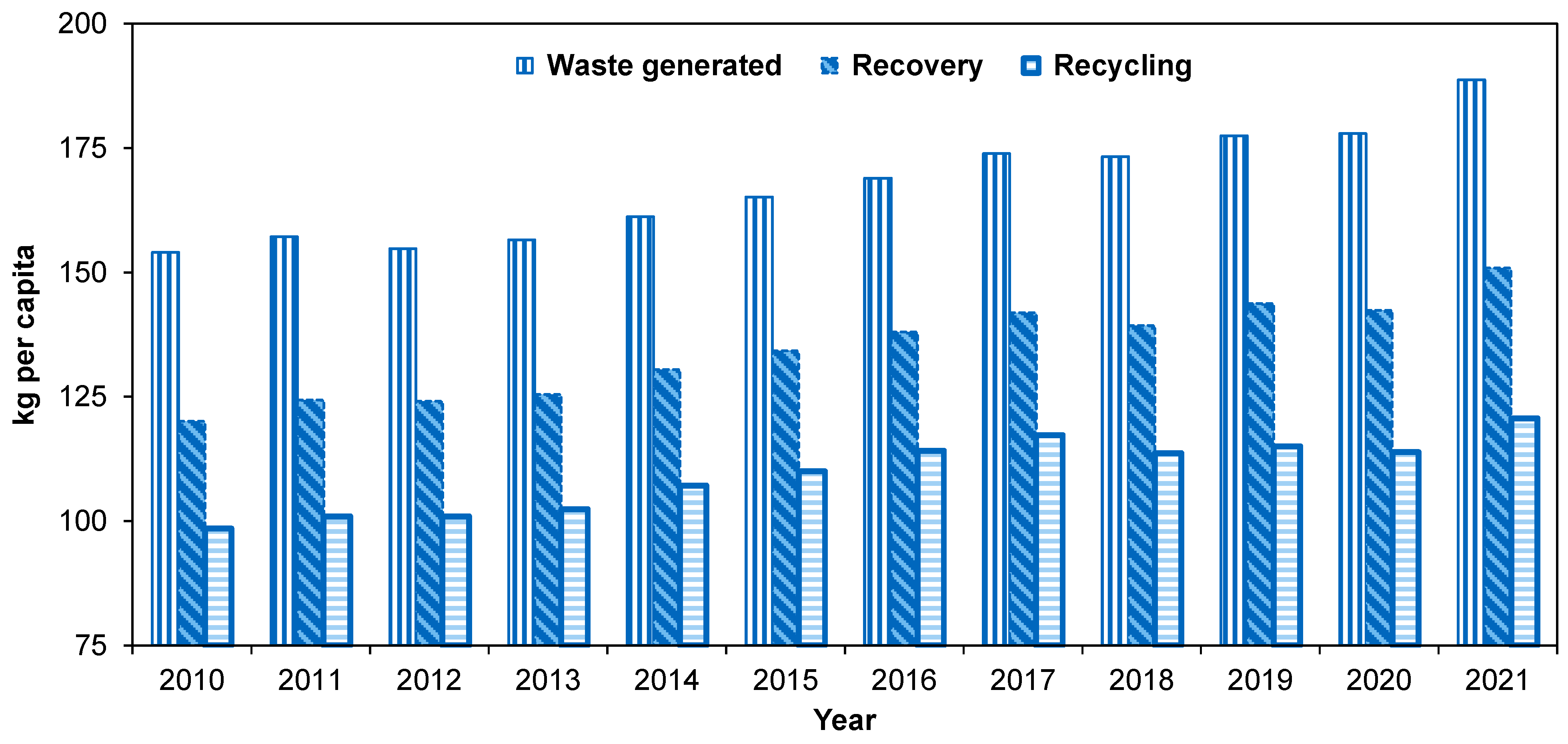
2. Recycled Materials for AM
3. Sustainable 3D Printing: Process Optimization and Environmental Impact
4. Considerations on Regulation and Standards
5. Challenges and Future Prospects
5.1. Challenges Identification in Using Recycled Polymers
5.2. Potential Advancements and Future Directions
6. Conclusions
Author Contributions
Funding
Informed Consent Statement
Data Availability Statement
Conflicts of Interest
Nomenclature
| 3D | Three-dimensional |
| ABS | Acrylonitrile butadiene styrene |
| AM | Additive manufacturing |
| ASTM | American Society for Testing and Materials |
| CAM | Computer-aided manufacturing |
| CNC | Computer numerical control |
| DMA | Dynamic mechanical analysis |
| DoE | Design of experiments |
| DSC | Differential scanning calorimetry |
| Eb | Elongation at break |
| EU | European Union |
| FDM | Fused deposition modeling |
| FEA | Finite element analysis |
| FFF | Fused filament fabrication |
| FTIR | Fourier-transform infrared spectroscopy |
| GPC | Gel permeation chromatography |
| HDPE | High-density polyethylene |
| HIPS | High-impact polystyrene |
| ISO | International Organization for Standardization |
| LDPE | Low-density polyethylene |
| MT | Metric ton |
| MFb | Maximum force at break |
| MFI | Melt flow index |
| NIST | National Institute of Standards and Technology |
| PC | Polycarbonate |
| PE | Polyethylene |
| PEEK | Polyether ether ketone |
| PET | Polyethylene terephthalate |
| PETG | Polyethylene terephthalate glycol modified |
| PLA | Polylactic acid |
| PP | Polypropylene |
| PPGF | Thermoplastic reinforced with glass fiber |
| PS | Polystyrene |
| PVC | Polyvinyl chloride |
| r | Material containing recycled polymer |
| REACH | Registration, evaluation, authorization, and restriction of chemicals |
| SEM | Scanning electron microscope |
| SLS | Selective laser sintering |
| SPE | Society of Plastics Engineers |
| TGA | Thermogravimetric analysis |
| TMod | Tensile modulus |
| TPE | Thermoplastic elastomer |
| TPU | Thermoplastic polyurethane |
| TS | Tensile strength |
| USA | United States of America |
| UTS | Ultimate tensile strength |
| XRD | X-ray diffraction |
| XRF | X-ray fluorescence |
References
- ISO/ASTM 52900:2021(En); Additive Manufacturing—General Principles—Fundamentals and Vocabulary. ISO: Geneva, Switzerland, 2021. Available online: https://www.iso.org/obp/ui#iso:std:iso-astm:52900:ed-2:v1:en (accessed on 25 January 2024).
- Olawumi, M.A.; Oladapo, B.I.; Ikumapayi, O.M.; Akinyoola, J.O. Waste to Wonder to Explore Possibilities with Recycled Materials in 3D Printing. Sci. Total Environ. 2023, 905, 167109. [Google Scholar] [CrossRef]
- Plastics Europe. Plastics—The Facts 2021; An Analysis of European Plastics Production, Demand and Waste Data; Plastics Europe: Frankfurt am Main, Germany, 2021. [Google Scholar]
- Plastics Europe. Plastics—The Facts 2022; Plastics Europe: Frankfurt am Main, Germany, 2022. [Google Scholar]
- European Bioplastics. Market Data. Available online: https://www.european-bioplastics.org/ (accessed on 1 June 2024).
- Statista. Global Plastic Industry. Available online: https://www.statista.com/topics/5266/plastics-industry/#topicOverview (accessed on 1 June 2024).
- European Commission. European Commission Reports. Available online: https://commission.europa.eu/publications_en (accessed on 1 June 2024).
- European Automobile Manufacturers Association. ACEA. Available online: https://www.acea.auto/ (accessed on 1 June 2024).
- European Chemical Industry Council (CEFIC). CEFIC: Brussels, Belgium. 2023. Available online: https://transition-pathway.cefic.org/ (accessed on 12 June 2024).
- Eurostat Statistics Explained. Packaging Waste Statistics. Available online: https://ec.europa.eu/eurostat/statistics-explained/index.php?title=Packaging_waste_statistics#Generation_and_recycling_per_inhabitant (accessed on 31 May 2024).
- Dassault Systèmes. 3D Printing and Recycled Materials|Dassault Systèmes. Available online: https://www.3ds.com/make/solutions/blog/3d-printing-and-recycled-materials (accessed on 5 January 2024).
- Bluhm, M. Ultimate Guide to Sustainable 3D Printing Materials: Pathing the Way for a Circular Economy. Available online: https://replique.io/2022/04/26/guide-to-sustainable-3d-printing-materials/ (accessed on 1 June 2024).
- Lodha, S.; Song, B.; Park, S.I.; Choi, H.J.; Lee, S.W.; Park, H.W.; Choi, S.K. Sustainable 3D Printing with Recycled Materials: A Review. J. Mech. Sci. Technol. 2023, 37, 5481–5507. [Google Scholar] [CrossRef]
- Hidalgo-Carvajal, D.; Muñoz, Á.H.; Garrido-González, J.J.; Carrasco-Gallego, R.; Alcázar Montero, V. Recycled PLA for 3D Printing: A Comparison of Recycled PLA Filaments from Waste of Different Origins after Repeated Cycles of Extrusion. Polymers 2023, 15, 3651. [Google Scholar] [CrossRef]
- Gil Muñoz, V.; Muneta, L.M.; Carrasco-Gallego, R.; de Juanes Marquez, J.; Hidalgo-Carvajal, D. Evaluation of the Circularity of Recycled PLA Filaments for 3D Printers. Appl. Sci. 2020, 10, 8967. [Google Scholar] [CrossRef]
- Patti, A.; Acierno, S.; Cicala, G.; Zarrelli, M.; Acierno, D. Assessment of Recycled PLA-Based Filament for 3D Printing. In Proceedings of the 2nd International Online Conference on Polymer Science—Polymers and Nanotechnology for Industry 4.0, Online, 1–15 November 2021; p. 16. [Google Scholar]
- Pan, G.T.; Chong, S.; Tsai, H.J.; Lu, W.H.; Yang, T.C.K. The Effects of Iron, Silicon, Chromium, and Aluminum Additions on the Physical and Mechanical Properties of Recycled 3D Printing Filaments. Adv. Polym. Technol. 2018, 37, 1176–1184. [Google Scholar] [CrossRef]
- Singh, N.; Singh, R.; Ahuja, I.P.S. On Development of Functionally Graded Material Through Fused Deposition Modelling Assisted Investment Casting from Al2O3/SiC Reinforced Waste Low Density Polyethylene. Trans. Indian Inst. Met. 2018, 71, 2479–2485. [Google Scholar] [CrossRef]
- Pinho, A.C.; Amaro, A.M.; Piedade, A.P. 3D Printing Goes Greener: Study of the Properties of Post-Consumer Recycled Polymers for the Manufacturing of Engineering Components. Waste Manag. 2020, 118, 426–434. [Google Scholar] [CrossRef]
- Moreno, E.; Beltrán, F.R.; Arrieta, M.P.; Gaspar, G.; Muneta, L.M.; Carrasco-Gallego, R.; Yáñez, S.; Hidalgo-Carvajal, D.; Orden, M.U.d.l.; Urreaga, J.M. Technical Evaluation of Mechanical Recycling of PLA 3D Printing Wastes. Proceedings 2021, 69, 19. [Google Scholar] [CrossRef]
- Domingues, J.; Marques, T.; Mateus, A.; Carreira, P.; Malça, C. An Additive Manufacturing Solution to Produce Big Green Parts from Tires and Recycled Plastics. Procedia Manuf. 2017, 12, 242–248. [Google Scholar] [CrossRef]
- Stoof, D.; Pickering, K. Sustainable Composite Fused Deposition Modelling Filament Using Recycled Pre-Consumer Polypropylene. Compos. B Eng. 2018, 135, 110–118. [Google Scholar] [CrossRef]
- Gaikwad, V.; Ghose, A.; Cholake, S.; Rawal, A.; Iwato, M.; Sahajwalla, V. Transformation of E-Waste Plastics into Sustainable Filaments for 3D Printing. ACS Sustain. Chem. Eng. 2018, 6, 14432–14440. [Google Scholar] [CrossRef]
- Tian, X.; Liu, T.; Wang, Q.; Dilmurat, A.; Li, D.; Ziegmann, G. Recycling and Remanufacturing of 3D Printed Continuous Carbon Fiber Reinforced PLA Composites. J. Clean. Prod. 2017, 142, 1609–1618. [Google Scholar] [CrossRef]
- Singh, R.; Kumar, R.; Tiwari, S.; Vishwakarma, S.; Kakkar, S.; Rajora, V.; Bhatoa, S. On Secondary Recycling of ZrO 2 -Reinforced HDPE Filament Prepared from Domestic Waste for Possible 3-D Printing of Bearings. J. Thermoplast. Compos. Mater. 2021, 34, 1254–1272. [Google Scholar] [CrossRef]
- Ragab, A.; Elazhary, R.; Schmauder, S.; Ramzy, A. Plastic Waste Valorization for Fused Deposition Modeling Feedstock: A Case Study on Recycled Polyethylene Terephthalate/High-Density Polyethylene Sustainability. Sustainability 2023, 15, 13291. [Google Scholar] [CrossRef]
- Gebrehiwot, S.Z.; Espinosa-Leal, L.; Linderbäck, P.; Remes, H. Optimising the Mechanical Properties of Additive-Manufactured Recycled Polylactic Acid (RPLA) Using Single and Multi-Response Analyses Methods. Int. J. Adv. Manuf. Technol. 2023, 129, 4909–4924. [Google Scholar] [CrossRef]
- EUMAKERS. EUBIO/2Life PLA Spool Pair: Recycled Filaments. Available online: https://www.eumakers.com/eubio-2life-pla-spool-pair-recycled-filaments.html (accessed on 10 January 2024).
- Filamentive. Materials. Available online: https://marketplace.ultimaker.com/app/cura/materials?author_id=filamentive&page=1 (accessed on 10 January 2024).
- ReFlow. ReFlow Filament. Available online: https://reflowfilament.com/ (accessed on 10 January 2024).
- Hopewell, J.; Dvorak, R.; Kosior, E. Plastics Recycling: Challenges and Opportunities. Philos. Trans. R. Soc. B Biol. Sci. 2009, 364, 2115–2126. [Google Scholar] [CrossRef]
- Al-Salem, S.M.; Lettieri, P.; Baeyens, J. Recycling and Recovery Routes of Plastic Solid Waste (PSW): A Review. Waste Manag. 2009, 29, 2625–2643. [Google Scholar] [CrossRef]
- Shukla, S.R.; Harad, A.M.; Jawale, L.S. Recycling of Waste PET into Useful Textile Auxiliaries. Waste Manag. 2008, 28, 51–56. [Google Scholar] [CrossRef]
- Akindoyo, J.O.; Beg, M.D.H.; Ghazali, S.; Islam, M.R.; Jeyaratnam, N.; Yuvaraj, A.R. Polyurethane Types, Synthesis and Applications—A Review. RSC Adv. 2016, 6, 114453–114482. [Google Scholar] [CrossRef]
- Wang, J.; Yang, B.; Lin, X.; Gao, L.; Liu, T.; Lu, Y.; Wang, R. Research of TPU Materials for 3D Printing Aiming at Non-Pneumatic Tires by FDM Method. Polymers 2020, 12, 2492. [Google Scholar] [CrossRef] [PubMed]
- Poulikakos, L.D.; Papadaskalopoulou, C.; Hofko, B.; Gschösser, F.; Cannone Falchetto, A.; Bueno, M.; Arraigada, M.; Sousa, J.; Ruiz, R.; Petit, C.; et al. Harvesting the Unexplored Potential of European Waste Materials for Road Construction. Resour. Conserv. Recycl. 2017, 116, 32–44. [Google Scholar] [CrossRef]
- Singh, B.; Gupta, M.; Tarannum, H. Mastic of Polymer-modified Bitumen and Poly(Vinyl Chloride) Wastes. J. Appl. Polym. Sci. 2003, 90, 1347–1356. [Google Scholar] [CrossRef]
- Garrido, J.; Silva, D.; Portela, B.; Lekube, B. Integrated User-oriented Service for 3d Printing Environments with Recycled Material from Maritime Plastic Waste. Appl. Sci. 2021, 11, 3787. [Google Scholar] [CrossRef]
- Cress, A.K.; Huynh, J.; Anderson, E.H.; O’neill, R.; Schneider, Y.; Keleş, Ö. Effect of Recycling on the Mechanical Behavior and Structure of Additively Manufactured Acrylonitrile Butadiene Styrene (ABS). J. Clean. Prod. 2021, 279, 123689. [Google Scholar] [CrossRef]
- Nattukallingal, M.N.; Ran, Z.; Abass, A. A Material-Recycling Unit for the Fused Deposition Modelling of Three-Dimensional Printing Systems. Appl. Sci. 2023, 13, 7515. [Google Scholar] [CrossRef]
- Azadani, M.N.; Whitehead, T.; Oyinlola, M. Modelling Heat Transfer in an Extruder for Recycling Plastics into Filaments for Use in Additive Manufacturing. In Proceedings of the 16th International Conference on Heat Transfer, Fluid Mechanics and Thermodynamics (HEFAT2022), Virtual, 8–10 August 2022. [Google Scholar]
- Mikula, K.; Skrzypczak, D.; Izydorczyk, G.; Warchoł, J.; Moustakas, K.; Chojnacka, K.; Witek-Krowiak, A. 3D Printing Filament as a Second Life of Waste Plastics—A Review. Environ Sci. Pollut. Res. 2020, 28, 12321–12333. [Google Scholar] [CrossRef]
- Farah, S.; Anderson, D.G.; Langer, R. Physical and Mechanical Properties of PLA, and Their Functions in Widespread Applications—A Comprehensive Review. Adv. Drug Deliv. Rev. 2016, 107, 367–392. [Google Scholar] [CrossRef]
- Carrasco, F.; Pagès, P.; Gámez-Pérez, J.; Santana, O.O.; Maspoch, M.L. Processing of Poly(Lactic Acid): Characterization of Chemical Structure, Thermal Stability and Mechanical Properties. Polym. Degrad. Stab. 2010, 95, 116–125. [Google Scholar] [CrossRef]
- Fico, D.; Rizzo, D.; Casciaro, R.; Corcione, C.E. A Review of Polymer-Based Materials for Fused Filament Fabrication (FFF): Focus on Sustainability and Recycled Materials. Polymers 2022, 14, 465. [Google Scholar] [CrossRef]
- Agbakoba, V.C.; Webb, N.; Jegede, E.; Phillips, R.; Hlangothi, S.P.; John, M.J. Mechanical Recycling of Waste PLA Generated From 3D Printing Activities: Filament Production and Thermomechanical Analysis. Macromol. Mater. Eng. 2023, 2300276. [Google Scholar] [CrossRef]
- Tanney, D.; Meisel, N.A.; Moore, J. Investigating Material Degradation through the Recycling of PLA in Additively Manufactured Parts. In Proceedings of the 28th Annual International Solid Freeform Fabrication Symposium—An Additive Manufacturing Conference, SFF 2017, Austin, TX, USA, 7–9 August 2017; pp. 519–531. [Google Scholar]
- Yoha, K.S.; Moses, J.A. 3D Printing Approach to Valorization of Agri-Food Processing Waste Streams. Foods 2023, 12, 212. [Google Scholar] [CrossRef] [PubMed]
- Cruz Sanchez, F.A.; Boudaoud, H.; Hoppe, S.; Camargo, M. Polymer Recycling in an Open-Source Additive Manufacturing Context: Mechanical Issues. Addit. Manuf. 2017, 17, 87–105. [Google Scholar] [CrossRef]
- Oussai, A.; Bártfai, Z.; Kátai, L. Development of 3D Printing Raw Materials from Plastic Waste. A Case Study on Recycled Polyethylene Terephthalate. Appl. Sci. 2021, 11, 7338. [Google Scholar] [CrossRef]
- Pricop, B.; Sava, Ș.D.; Lohan, N.M.; Bujoreanu, L.G. DMA Investigation of the Factors Influencing the Glass Transition in 3D Printed Specimens of Shape Memory Recycled PET. Polymers 2022, 14, 2248. [Google Scholar] [CrossRef] [PubMed]
- Vidakis, N.; Petousis, M.; Tzounis, L.; Grammatikos, S.A.; Porfyrakis, E.; Maniadi, A.; Mountakis, N. Sustainable Additive Manufacturing: Mechanical Response of Polyethylene Terephthalate Glycol over Multiple Recycling Processes. Materials 2021, 14, 1162. [Google Scholar] [CrossRef] [PubMed]
- Vidakis, N.; Petousis, M.; Tzounis, L.; Maniadi, A.; Velidakis, E.; Mountakis, N.; Papageorgiou, D.; Liebscher, M.; Mechtcherine, V. Sustainable Additive Manufacturing: Mechanical Response of Polypropylene over Multiple Recycling Processes. Sustainability 2020, 13, 159. [Google Scholar] [CrossRef]
- Plummer, K.; Vasquez, M.; Majewski, C.; Hopkinson, N. Study into the Recyclability of a Thermoplastic Polyurethane Powder for Use in Laser Sintering. Proc. Inst. Mech. Eng. B J. Eng. Manuf. 2012, 226, 1127–1135. [Google Scholar] [CrossRef]
- Nanni, A.; Crosetta, L.; La Fauci, G.; Biagi, F.; Parisi, M.; Colombo, D.; Colonna, M. Study of the Mechanical Properties of Thermoplastic Polyurethane (TPU) Recycled from End-of-Life Ski-Boots and Techno-Economic Analysis (TEA) of the Mechanical Recycling Processes. Sustain. Chem. Pharm. 2023, 33, 101059. [Google Scholar] [CrossRef]
- Vidakis, N.; Petousis, M.; Mountakis, N.; David, C.N.; Sagris, D.; Das, S.C. Thermomechanical Response of Thermoplastic Polyurethane Used in MEX Additive Manufacturing over Repetitive Mechanical Recycling Courses. Polym. Degrad. Stab. 2023, 207, 110232. [Google Scholar] [CrossRef]
- Romani, A.; Levi, M.; Pearce, J.M. Recycled Polycarbonate and Polycarbonate/Acrylonitrile Butadiene Styrene Feedstocks for Circular Economy Product Applications with Fused Granular Fabrication-Based Additive Manufacturing. Sustain. Mater. Technol. 2023, 38, e00730. [Google Scholar] [CrossRef]
- Reich, M.J.; Woern, A.L.; Tanikella, N.G.; Pearce, J.M. Mechanical Properties and Applications of Recycled Polycarbonate Particle Material Extrusion-Based Additive Manufacturing. Materials 2019, 12, 1642. [Google Scholar] [CrossRef] [PubMed]
- Schwarz, A.E.; Ligthart, T.N.; Godoi Bizarro, D.; De Wild, P.; Vreugdenhil, B.; van Harmelen, T. Plastic Recycling in a Circular Economy; Determining Environmental Performance through an LCA Matrix Model Approach. Waste Manag. 2021, 121, 331–342. [Google Scholar] [CrossRef] [PubMed]
- Oladapo, B.I.; Bowoto, O.K.; Adebiyi, V.A.; Ikumapayi, O.M. Net Zero on 3D Printing Filament Recycling: A Sustainable Analysis. Sci. Total Environ. 2023, 894, 165046. [Google Scholar] [CrossRef] [PubMed]
- Kreiger, M.A.; Mulder, M.L.; Glover, A.G.; Pearce, J.M. Life Cycle Analysis of Distributed Recycling of Post-Consumer High Density Polyethylene for 3-D Printing Filament. J. Clean. Prod. 2014, 70, 90–96. [Google Scholar] [CrossRef]
- Nikam, M.; Pawar, P.; Patil, A.; Patil, A.; Mokal, K.; Jadhav, S. Sustainable Fabrication of 3D Printing Filament from Recycled PET Plastic. Mater. Today Proc. 2023; in press. [Google Scholar] [CrossRef]
- Feeley, S.R.; Wijnen, B.; Pearce, J.M. Evaluation of Potential Fair Trade Standards for an Ethical 3-D Printing Filament. J. Sustain. Dev. 2014, 7, 1–12. [Google Scholar] [CrossRef]
- Mani, M.; Lyons, K.W.; Gupta, S.K. Sustainability Characterization for Additive Manufacturing. J. Res. Natl. Inst. Stand. Technol. 2014, 119, 419–428. [Google Scholar] [CrossRef]
- Pat Picariello. Committee F42 on Additive Manufacturing Technologies. Available online: https://www.astm.org/committee-f42 (accessed on 25 January 2024).
- Wikipedia. Registration, Evaluation, Authorisation and Restriction of Chemicals. Available online: https://en.wikipedia.org/wiki/Registration,_Evaluation,_Authorisation_and_Restriction_of_Chemicals (accessed on 24 January 2024).
- Rejeski, D.; Zhao, F.; Huang, Y. Research Needs and Recommendations on Environmental Implications of Additive Manufacturing. Addit. Manuf. 2018, 19, 21–28. [Google Scholar] [CrossRef]
- Forster, A.M. Materials Testing Standards for Additive Manufacturing of Polymer Materials: State of the Art and Standards Applicability; National Institute of Standards and Technology: Gaithersburg, MD, USA, 2015.
- Kietzmann, J.; Pitt, L.; Berthon, P. Disruptions, Decisions, and Destinations: Enter the Age of 3-D Printing and Additive Manufacturing. Bus. Horiz. 2015, 58, 209–215. [Google Scholar] [CrossRef]
- European Parliament and Council. Regulation (EC) No 1907/2006 of the European Parliament and of the Council of 18 December 2006 Concerning the Registration, Evaluation, Authorisation and Restriction of Chemicals (REACH). Available online: https://eur-lex.europa.eu/legal-content/EN/TXT/?uri=CELEX%3A02006R1907-20221217 (accessed on 24 January 2024).
- ISO. ISO Standards. Available online: https://www.iso.org/obp/ui/#home (accessed on 24 January 2024).
- The American Chemical Society (ACS). Available online: https://www.acs.org/ (accessed on 25 January 2024).
- The Society of Plastics Engineers (SPE). Available online: https://www.spe.org/en/ (accessed on 25 January 2024).
- Vidakis, N.; Petousis, M.; Tzounis, L.; Maniadi, A.; Velidakis, E.; Mountakis, N.; Kechagias, J.D. Sustainable Additive Manufacturing: Mechanical Response of Polyamide 12 over Multiple Recycling Processes. Materials 2021, 14, 466. [Google Scholar] [CrossRef]
- Mishra, V.; Ror, C.K.; Negi, S.; Kar, S.; Borah, L.N. 3D Printing with Recycled ABS Resin: Effect of Blending and Printing Temperature. Mater. Chem. Phys. 2023, 309, 128317. [Google Scholar] [CrossRef]
- Cruz Sanchez, F.A.; Boudaoud, H.; Camargo, M.; Pearce, J.M. Plastic Recycling in Additive Manufacturing: A Systematic Literature Review and Opportunities for the Circular Economy. J. Clean. Prod. 2020, 264, 121602. [Google Scholar] [CrossRef]
- Wang, X.; Jiang, M.; Zhou, Z.; Gou, J.; Hui, D. 3D Printing of Polymer Matrix Composites: A Review and Prospective. Compos. B Eng. 2017, 110, 442–458. [Google Scholar] [CrossRef]
- Ngo, T.D.; Kashani, A.; Imbalzano, G.; Nguyen, K.T.Q.; Hui, D. Additive Manufacturing (3D Printing): A Review of Materials, Methods, Applications and Challenges. Compos. B Eng. 2018, 143, 172–196. [Google Scholar] [CrossRef]
- Oliveira, D.M.V. Recycling Station for Thermoplastic Polymers for 3D Printing; University of Lisbon: Lisbon, Portugal, 2018. [Google Scholar]
- Lehrer, J.; Scanlon, M. The Development of a Sustainable Technology for 3D Printing Using Recycled Materials. In Proceedings of the 2017 Mid-Atlantic Section Fall Conference, Reading, PA, USA, 6–7 October 2017. [Google Scholar]

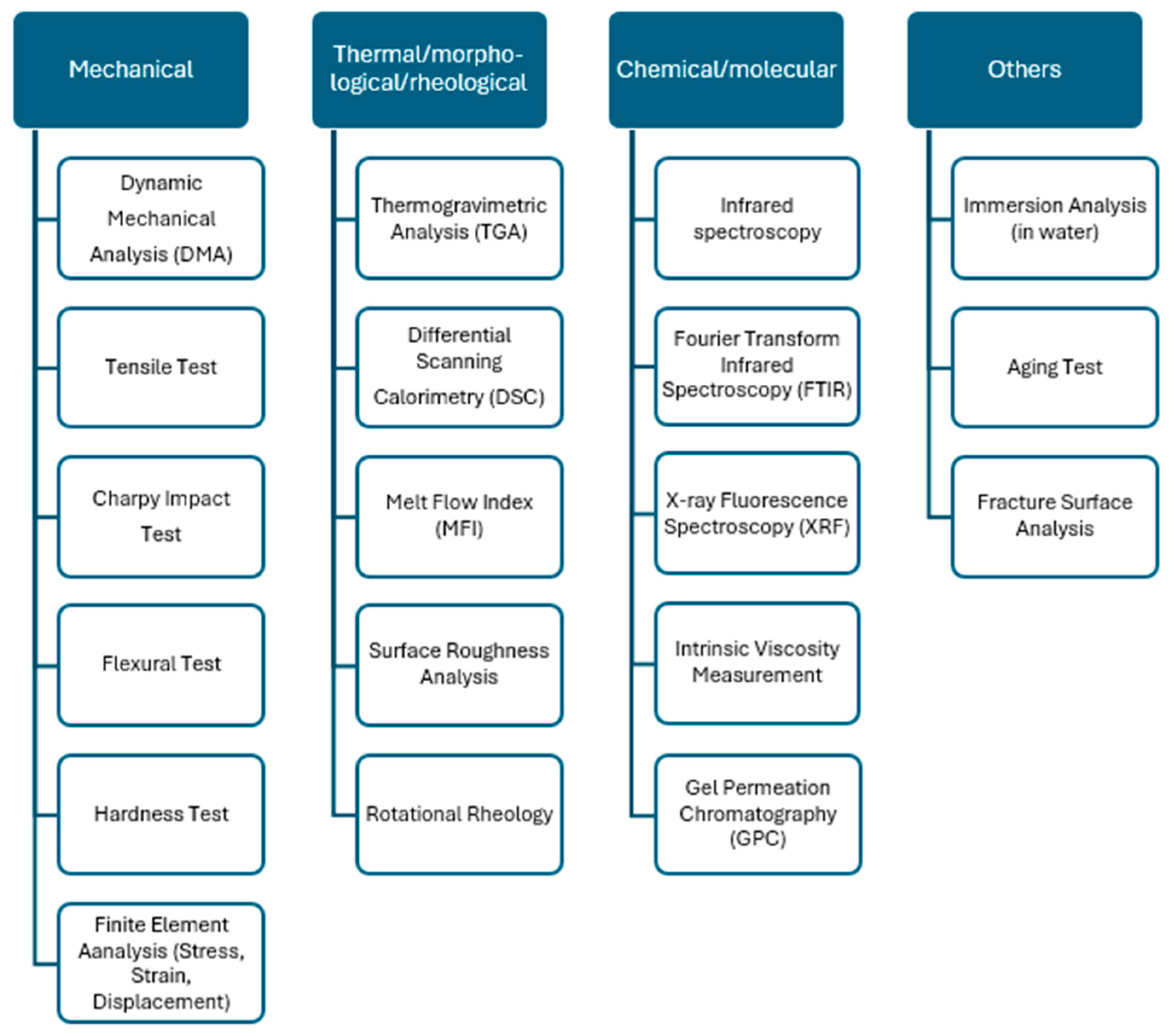
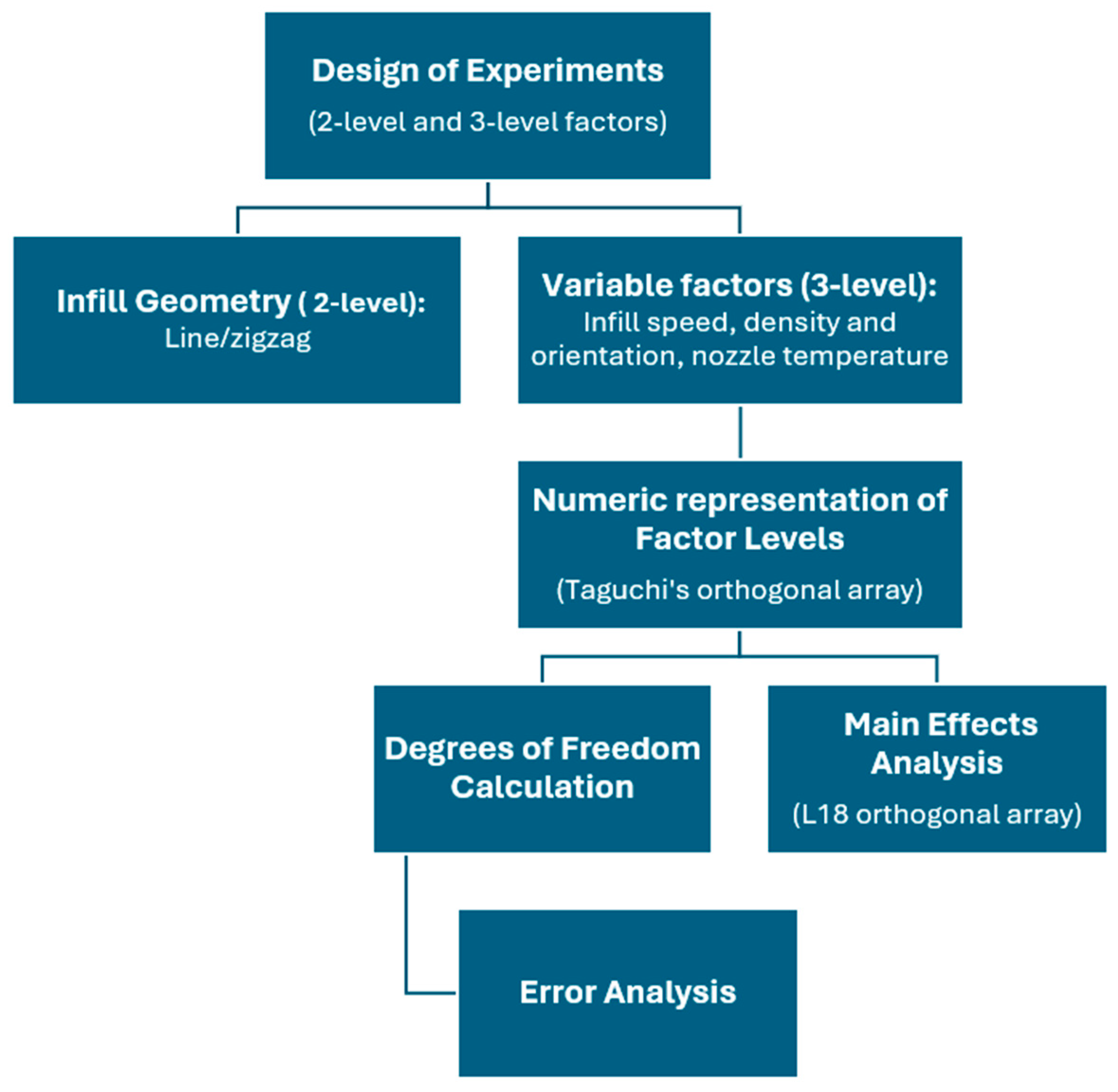
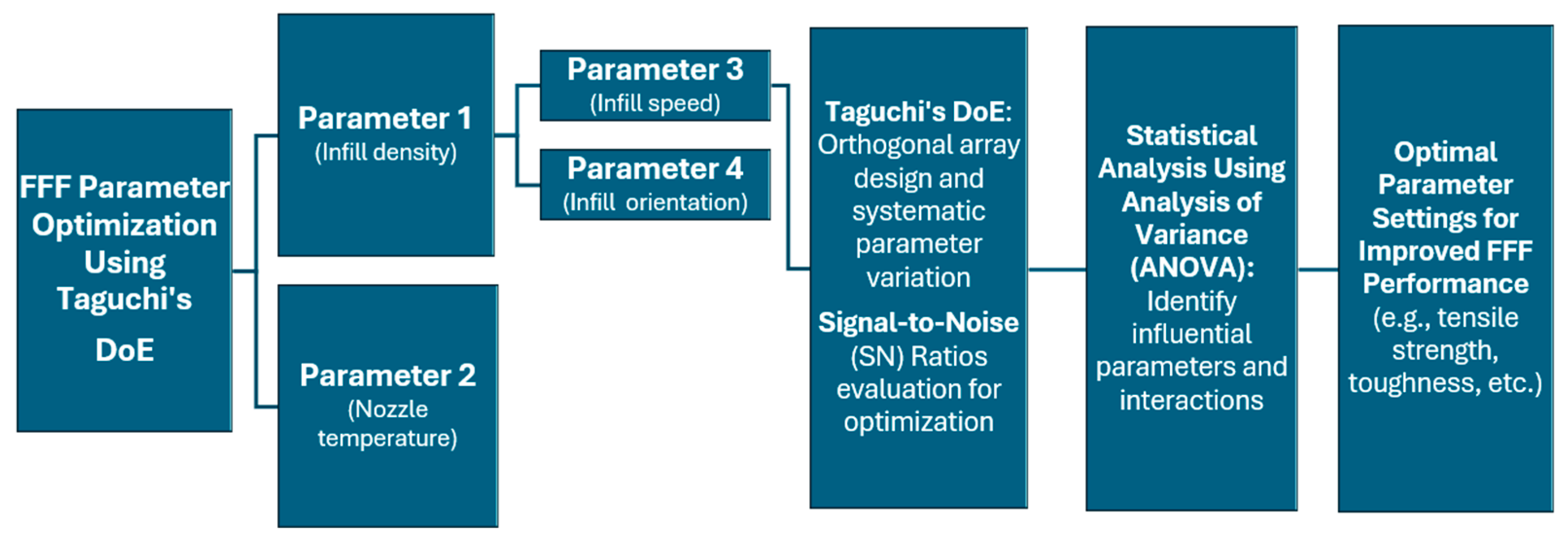

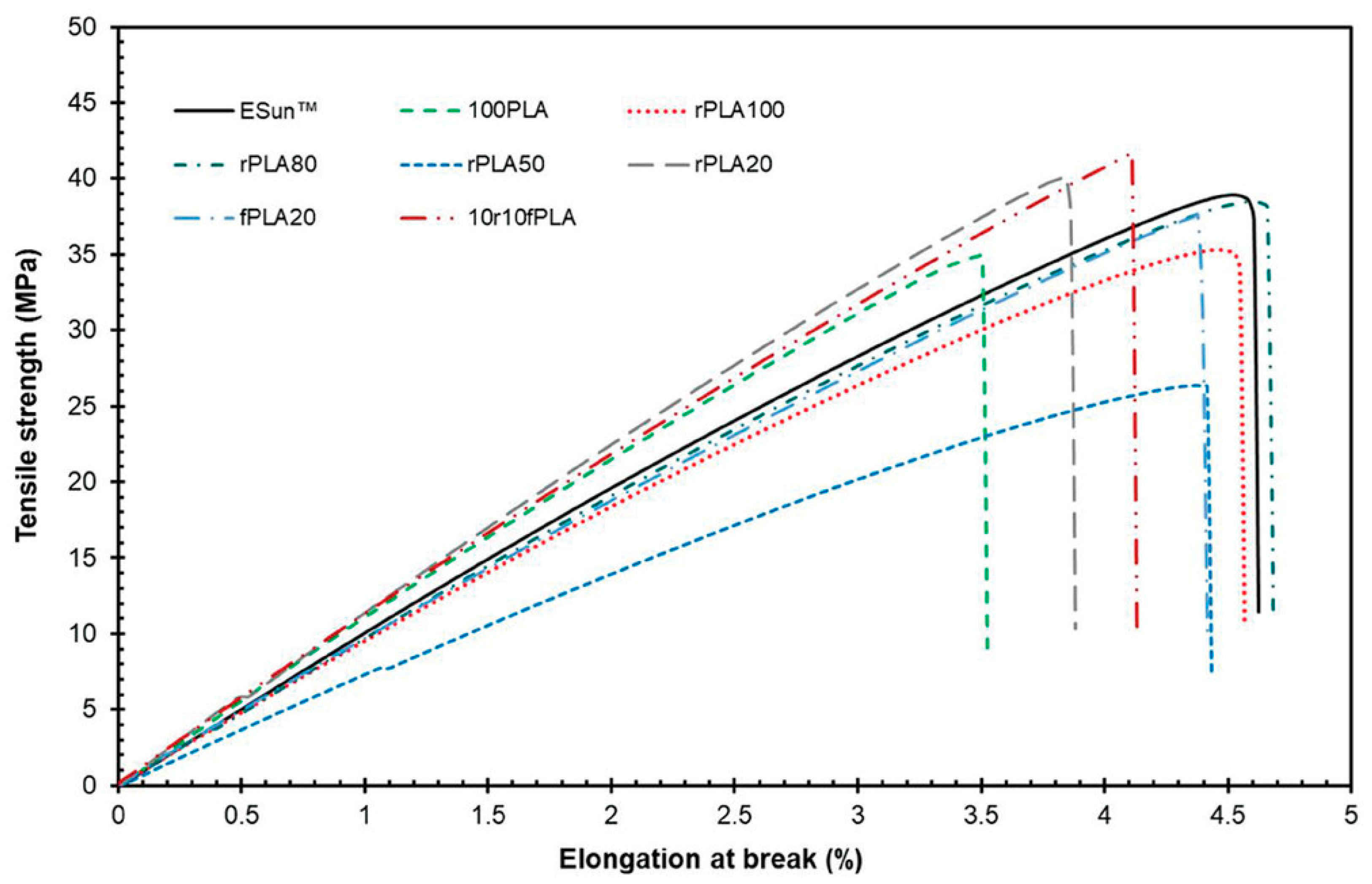
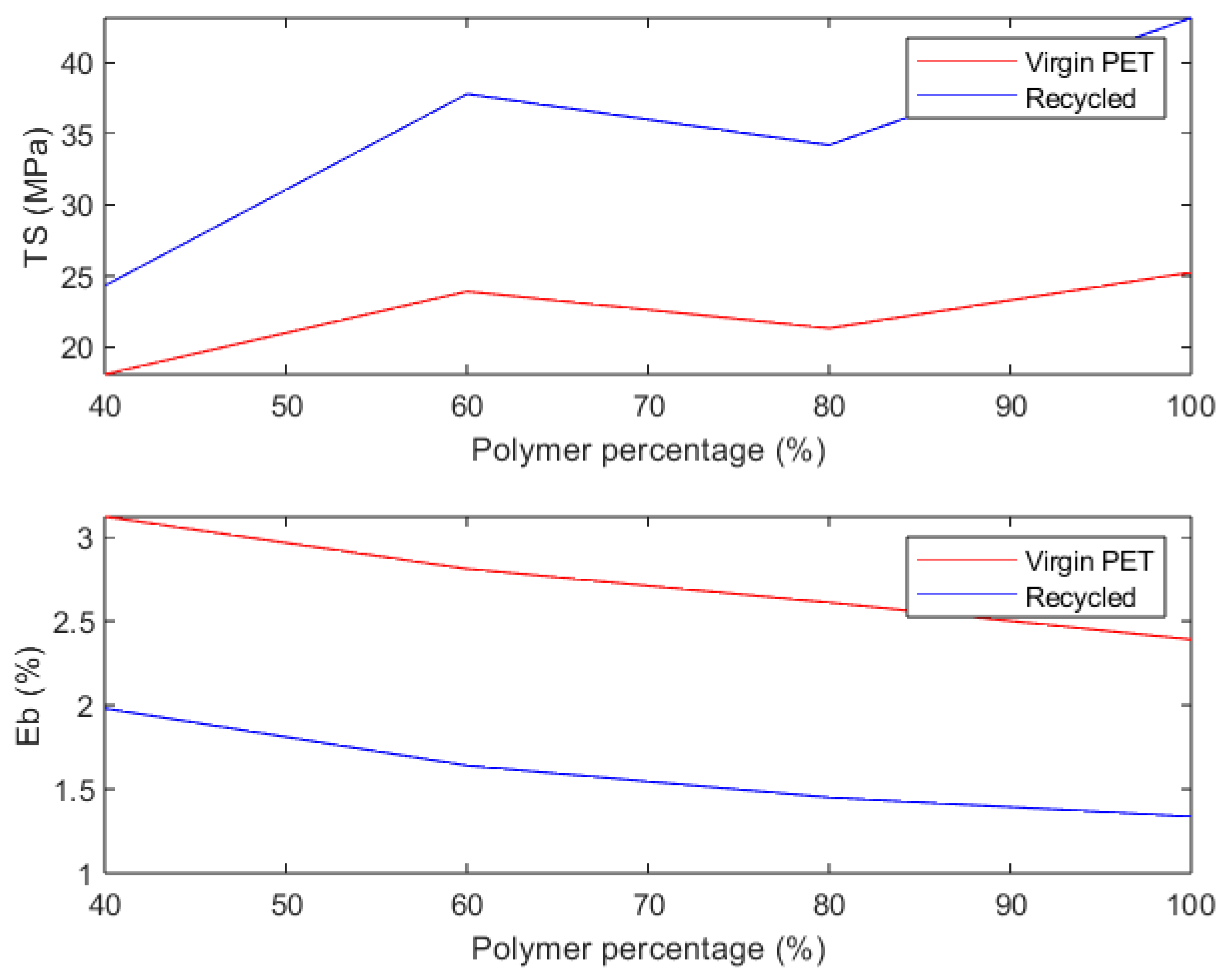
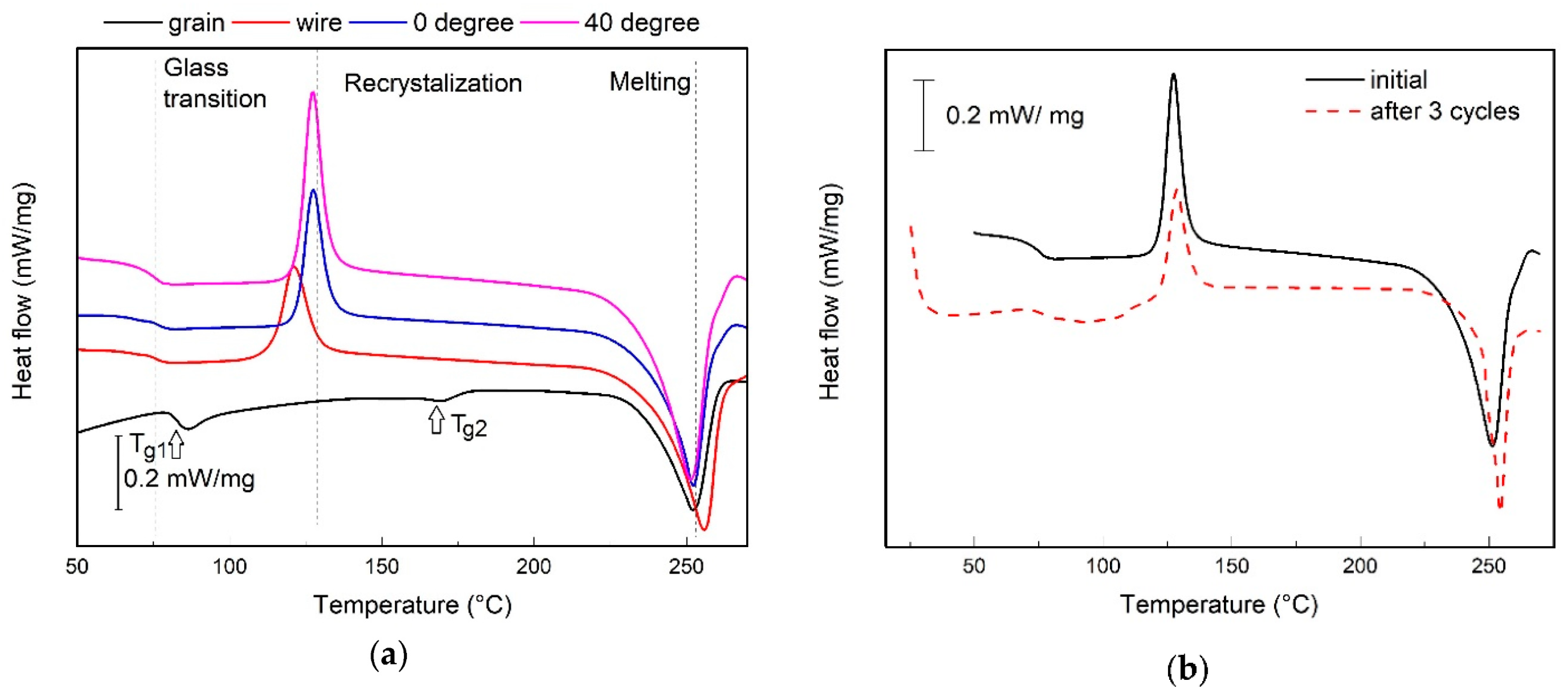

| Material | Type of Material | Printing Methodologies | Price per kg (EUR) | Company | Features |
|---|---|---|---|---|---|
| PET | Pellets/Flakes | FDM, injection, molding | 1.70–2.20 | Carbon LITE (Los Angeles, CA, USA), Loop Industries (Terrebonne, QC, Canada), Envision Plastics (Reidsville, NC, USA | High transparency, lightweight, and strong. |
| HDPE | Pellets | FDM, injection, molding | 1.50–1.80 | KW polymers (Troy, AL, USA), green Line polymers (Waterloo, IA, USA), MBA Polymers (Hackensack, NJ, USA) | High strength, stiffness, and chemical resistance. |
| PP | Pellets | FDM, injection, molding | 1.20–1.80 | LyondellBasell (Rotterdam, The Netherlands) | Lightweight, high chemical resistance, and low moisture absorption. |
| ABS | Pellets | FDM, injection, molding | 1.50–2.00 | Total Petrochemicals (Houston, TX, USA), INEOS Styrolution (Frankfurt, Germany) | High-impact resistance, strength, and toughness. |
| PLA | Pellets | FDM | 1.60–1.90 | Nature Works (Minneapolis, MN, USA), 3D FUEL (Fargo, ND, USA) | Biodegradable, derived from renewable resources. |
| Nylon | Pellets | FDM, SLS | 1.80–2.10 | BASF (Ludwigshafen, Germany), Evonik (Essen, Germany) | High strength, flexibility, and durability. |
| PEEK | Pellets | FDM, SLS | 1.60–2.00 | Solvay (Brussels, Belgium) | High-temperature resistance, chemical resistance, and stiffness. |
| TPU | Pellets | FDM | 2.50–3.50 | Lubrizol (Wickliffe, OH, USA) | Flexible, durable, and abrasion-resistant. |
| PC | Pellets | FDM, injection, molding | 1.80–2.20 | Covestro (Leverkusen, Germany), SABIC (Riyadh, Saudi Arabia) | High impact resistance, optical clarity, and heat resistance. |
| PS | Pellets | FDM, injection, molding | 2.00–2.50 | INEOS Styrolution (Frankfurt, Germany), BASF (Ludwigshafen, Germany) | Lightweight and rigid. |
| Material | Type of Material | Origin | Price (EUR) | Company | Advantages | Source |
|---|---|---|---|---|---|---|
| PLA | Filaments | Production waste | 26.50 | EUMAKERS (Barletta, Italy) | Not specified. | [28] |
| PLA | Filaments in different colors | Factory waste streams | 20–22 | Filamentive (Bradford, UK) | Low warping, limited smell, and good print quality. | [29] |
| PLA | Filaments in different colors | Food packaging waste | 26.32 | Reflow Filament (Amsterdam, The Netherlands) | Easy to print, durable, and excellent print quality. | [30] |
| rPETG | Filaments | Leading local recyclers | 28 | Reflow Filament (Amsterdam, The Netherlands) | Durable and easy to use, exceptional visual, and mechanical performance. | [30] |
| rPPGF | Filaments | Fishing nets and ropes reinforced with glass fiber | Not specified | Reflow Filament (Amsterdam, The Netherlands) | Anti-warping, and excellent UV and chemical resistance. | [30] |
| S/N | Filament | Description | Filament Diameter [mm] |
|---|---|---|---|
| 1 | ESun | Commercial filament | 1.72 (±0.03) |
| 2 | 100PLA | 100% virgin PLA | 1.65 (±0.02) |
| 3 | rPLA100 | 100% virgin recycled PLA | 1.67 (±0.11) |
| 4 | rPLA80 | 80% recycled PLA + 20% virgin PLA | 1.65 (±0.12) |
| 5 | rPLA50 | 50% recycled PLA + 50% PLA | 1.67 (±0.10) |
| 6 | rPLA20 | 20% recycled PLA + 80% virgin PLA | 1.64 (±0.08) |
| 7 | fPLA20 | 20% recycled biocomposite filament f + 80% virgin PLA | 1.70 (±0.02) |
| 8 | 10r10fPLA | 10% rPLA + 10% fPLA, +80% virgin PLA | 1.68 (±0.07) |
| Polymer Type | Shear Strength (MPa) | Hardness (Shore D) |
|---|---|---|
| Virgin | 28.45 ± 0.69 | 73.10 ± 0.73 |
| Recycled | 29.25 ± 2.00 | 68.71 ± 2.00 |
Disclaimer/Publisher’s Note: The statements, opinions and data contained in all publications are solely those of the individual author(s) and contributor(s) and not of MDPI and/or the editor(s). MDPI and/or the editor(s) disclaim responsibility for any injury to people or property resulting from any ideas, methods, instructions or products referred to in the content. |
© 2024 by the authors. Licensee MDPI, Basel, Switzerland. This article is an open access article distributed under the terms and conditions of the Creative Commons Attribution (CC BY) license (https://creativecommons.org/licenses/by/4.0/).
Share and Cite
Djonyabe Habiba, R.; Malça, C.; Branco, R. Exploring the Potential of Recycled Polymers for 3D Printing Applications: A Review. Materials 2024, 17, 2915. https://doi.org/10.3390/ma17122915
Djonyabe Habiba R, Malça C, Branco R. Exploring the Potential of Recycled Polymers for 3D Printing Applications: A Review. Materials. 2024; 17(12):2915. https://doi.org/10.3390/ma17122915
Chicago/Turabian StyleDjonyabe Habiba, Rachel, Cândida Malça, and Ricardo Branco. 2024. "Exploring the Potential of Recycled Polymers for 3D Printing Applications: A Review" Materials 17, no. 12: 2915. https://doi.org/10.3390/ma17122915
APA StyleDjonyabe Habiba, R., Malça, C., & Branco, R. (2024). Exploring the Potential of Recycled Polymers for 3D Printing Applications: A Review. Materials, 17(12), 2915. https://doi.org/10.3390/ma17122915







